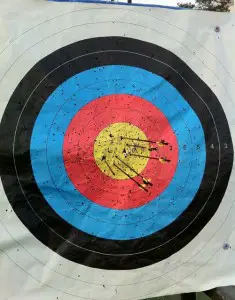 20,000 BC – Primitive pictures of a bow and arrows are crudely drawn on a cave wall. The pictures seemed to represent hunting, perhaps indicating the first time that bows and arrows were utilized as tools. The drawings were found in Valltorta Gorge in Spain.
20,000 BC – Primitive pictures of a bow and arrows are crudely drawn on a cave wall. The pictures seemed to represent hunting, perhaps indicating the first time that bows and arrows were utilized as tools. The drawings were found in Valltorta Gorge in Spain.
25,000-18,000 BC – Flint arrowheads have been found from this period of history. Interestingly, they started to crop up in Egypt and Germany around the same time. This was one of the first indications of ocean travel. How else could arrows appear on both sides of the Mediterranean?
9000 BC – Arrow shafts from 11000 years ago were found all over, particularly in Egypt though. It is believed that these arrows had feathers attached to their shaft with sinew glue.
8000 – 6000 BC – One-piece yew (elm) bows are found in Denmark. These bows are so impressive because they are tillered, meaning that they are evenly bent on both sides of the bow. This indicates that thought was put into improving the bows. This sign of innovation is fascinating for historians.
7500 BC – A Tassai rock fresco of an ancient Egyptian archer was discovered. The fresco showed fire-hardened points on arrows, or flint arrowheads tied on with sinew.
3500 BC – Egyptians perfect the longbow, it finally becomes their primary weapon of war. Their tremendous range allowed them to pick hugely advantageous fights with their neighboring countries.
3300 BC – The preserved body of a man, called Otzi the iceman, was found on the Similaun Glacier in the Alps in 1991. This was a particularly amazing discovery because he was found with a quiver, containing 14 arrows. He is the oldest natural mummy in all of Europe.
1800 BC – The Assyrians begin using the recurve-shaped bow en masse. This is a short composite bow that is incredibly powerful. It fires arrows reasonably far (not as far as a longbow) but most importantly fires them quickly. These bows were made of leather, horn, and wood.
1200 BC – The Hittites begin using a short recurve bow. This is one of the earliest signs of mobile warfare. They would do battle by shooting from their chariots. They would faint the enemy and then pull back, all while littering them with arrows. Their chariots were fast and light, so they could outrun enemy cavalry if needed.
1066 – The Normans led by William, Duke of Normandy, managed to defeat King Harold and the Anglo-Saxons at the Battle of Hastings. William managed to gain control of the hills on the battlefield, he used this advantage to give his archers increased range and vision of the battlefield.
13th-14th centuries – Longbow-men became the very core of the English army. Combined with their superior fortification and cavalry, they were used to suppress the surrounding countries. English castles could simply not be captured by anyone who didn’t match them an archer for an archer.
1363 – English kings changed the laws of the land to require Englishmen to practice archery. This practice was supposed to be held on Sundays and holidays, no other sport or pass time was given the same priority. The idea was that should the local populace need to be conscripted for war, they would already be proficient archers.
15th century – Making everyone study the bow slightly backfired, poaching became commonplace and restrictions had to be put in place. It was at this time that the tales of Robin Hood started to flourish. Sherwood Forrest is still an important site in the Nottingham area.
16th century – As firearms begin to enter circulation bows and arrows are gradually phased out. The superpowers of Europe managed to achieve this first, leading to their rapid colonization of other populaces. This is how Britain managed to subjugate almost the entire world. Its easier to win wars when no one else has guns.
1537 – Under the orders of King Henry VIII of England, Sir Christopher Morris was tasked with establishing the world’s first archery society. The guild of Saint George.
1545 – The famous book Toxophilus is published by Roger Ascham. This book details the history and practical uses of the long since redundant longbow.
1600 – Archery begins to make its way back into the public eye as a competitive sport. Various archery societies were created, they would often compete with each other for prestige and money.
1620 – European settlers who made their way to North America bring their knowledge of bow making with them. The native populace had very different types of bows and fired them in various ways. They would hold multiple arrows in their hand, letting one go at a time as they fired them. This was in the place of quivers and allowed the Native Americans to fire 4 arrows in about 2 seconds.
1673 – The very first Scorton Silver Arrow Contest was held in Yorkshire, England. This ancient contest has continued to grow in popularity and continues to be held today.
1787 – For the first time women are allowed to take part in archery. They are inducted into the various archery societies and allowed to compete. Typically in a women’s only division of the competition, as they would today.
1828 – The United Bowmen of Philadelphia archery club opens. This was the first archery society in North America and is one of the first steps the US took towards becoming an extremely competitive nation of archers.
1878 – The Witchery of Archery by Will and Maurice Thompson was published. They were taught archery by some Native Americans. It gave a very detailed insight into the way they thought, hunted, and fought.
1879 – The NAA (National Archery Association) is founded. They quickly begin hosting national tournaments. This laid the groundwork for the Olympic archery teams in the years to follow.
1900 – Archery finally becomes an official Olympic event. Every few years new sports are inducted into the Olympics. Finally, archery was given the respect it deserves and became an Olympic sport at the Paris summer games.
1920 – Archery takes the center stage at its second Olympic games this time in Belgium. Belgian born Hubert Van Innis managed to bring home the Gold in front of the home crowd fans.
1931 – The Fédération Internationale de Tir à l’Arc (FITA) was founded in Poland, in 1931. This association is made up of hundreds of different countries’ archery associations. They are responsible for rule changes and the planning of events.
1937 – This is the first time that bow sights were allowed to be used at an NAA tournament. This began the transition away from more traditional archery and brought the sport into the modern age.
1938 – Ben Pearson was a huge fan of archery. Eventually, he went on to create his own archery supplies company. He mass-produced bows arrows and other little bits and pieces one might need. He is partially responsible for the growth of the sport, as it was now more accessible. This company is still around today.
1939 – The National Field Archery Association is finally established. It is responsible for organizing traditional archery competitions as well as more modern ones. They have various classes of bow you can compete with.
1946 – Doug Easton worked very hard to develop an efficient process of manufacturing aluminum arrow shafts. These strong, yet light, arrow shafts greatly increased the accuracy and the speed of the arrow.
1951 – Gradually, plastic vanes were used to replace feathers as arrow guides. This was easier to produce, cheaper to produce, and just as effective. Even more so in many cases. As plastic vanes can be created exactly right, feathers are all slightly different.
1960 – H.W. Alan from Missouri, USA invented the now commonplace compound bow. This bow can shoot farther and faster than the alternative bows on the market. It also has far more stopping power. Compound bows are perfect for big game hunting.
1961 – Eventually, the Hoyt Archery Company managed to create bows with attached stabilizers. These stabilizers made shooting accurately over long distances far easier. Many people pushed back at this invention calling it cheating. How you feel about that is up to you, of course.
1970 – Release aids for compound bows are finally allowed in competitive archery. These release aids are essentially like a trigger for the bow so you release the arrow more accurately. Again, many people pushed back against this upgrade to the world of competitive archery.
1972 – Archery finally becomes a permanent addition to the Olympic games. This is the last time that archery will ever need to be voted into the Olympic games. By now it is far too important and popular. It is classed by many countries as a main event. It would be shocking to see it cut from the lineup.
2011 – FITA eventually changes its name to WA (World Archery Federation).
Source: Archery: Steps to Success by Kathleen Haywood and Catherine Lewis



Vikings aren’t included on the timeline!! Where abouts would they be??
Thank you, this was a nice refresher as I have to teach about the history of bows and arrows soon.
Ref comment at 1787 – As far as I know ladies have never shot at the Scorton, They have their own competition called the Ilkley Arrow.
Ladies are considered to have first shot competitively with the Royal British Bowmen from 1787 to 1794 and again when they were reformed in 1819, although there is written evidence of ladies using the bow for “field sports” as early as 1605 and images of peasant women hunting with the bow which are even earlier.
Ref comment on Olympics. There was limited archery in 1900 and again in USA in 1904 The next time was 1908 in London
There is also a great deal left out (as Tamsin remarks) but this is inevitable or the line would be a very very long one. Also a tendency for the later comments to be weighted toward the USA but this is expected when the source is an American book.
Outstanding timeline of archery history, Thank you!
This was suuuuuch a great source
thank you so much! this is so much help for be….
I’m doing a project about Bows and Arrows!
your website was very useful to me cause it got me the best grade in the holy school thank you soooo much for getting A in my class
Thanks for showing the history of archery.
thank you this really helped with my 4-H project
Pretty! This was an extremely wonderful article. Thanks for supplying this information.